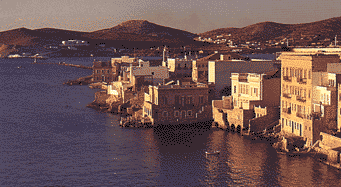SYROS
 Syros
is situated in the middle of the group of islands called the Cyclades. Other
islands nearby (from northeast to south) are Andros, Tinos, Mykonos, Naxos,
(from southwest to west) Sifnos, Serifos, Kythnos and Kea, and Yaros on the
north. The northern part of the island is mountainous, while the southern part
is relatively flat. Most villages and organized beaches are to be found here.
Syros
is situated in the middle of the group of islands called the Cyclades. Other
islands nearby (from northeast to south) are Andros, Tinos, Mykonos, Naxos,
(from southwest to west) Sifnos, Serifos, Kythnos and Kea, and Yaros on the
north. The northern part of the island is mountainous, while the southern part
is relatively flat. Most villages and organized beaches are to be found here.
The
Phoenicians were the first inhabitants of the island. Syros is mentioned in
Homer's Odyssey as "Syrii" and is said to have had two cities
Posidonia and Phoeniki. The name Syros is probably a derivation from one of the
Phoenician words "ousyra" (prosperous) or "syr" (rock).
Archaeological
excavations have brought to light various objects and other traces of human life
from the Bronze age (4000 - 3000 BC). In the areas of Kastri and Chalandriani
graves and organized settlements from the early Cycladic period (about
3000 BC) were discovered. At that time the so called Syros- Keros civilization
was developed, which flourished until about 2000 BC. In ancient times Syros was
a member of the Athenian alliance. Philosopher Pherekydes, teacher of Pythagoras
and inventor of the heliotrope, lived in Syros at that time. The cave he used to
live in can still be found in Ano Meria (the northern part of the island).
As
most of the Aegean islands, Syros has suffered from pirate raids for many
centuries. Due to that fact most settlements were built on hilltops for
protection. The island has been inhabited by Phoenicians, Cretans, Ionians,
Athenians, Romans, Byzantines, Venetians and Turks. The Venetian influence can
still be seen on the island in the midieval city of Ano Syros and its towering
church dedicated to Saint George.
Syros
reached the height of its prosperity after the Greek revolution of 1821. People
who had revolted against the ottomans arrived to Syros from various parts of
Greece as refugees. In a short period of time they developed the wonder of
Hermoupolis which soon became a great commercial center and the most important
port of the Eastern Medditerranean. In 1823 the first Greek hospital is
founded here. In 1833 the first Greek Gymnasium is founded by Neofytos Vamvas,
and a few years later Elefterios Venizelos will be one of its students.
Many shipyards are founded, and about 2,000 workers manage to build up to 80
ships per year. The first Greek steamship is built in Syros in 1854.
At
the same time, banking and insurance market is developed. After 1855
industry flourishes, especially tanning, soap manufacturing, iron works,
grinding, textile works etc. The city continues to flourish until the end of the
19th century and by that time about 30,000 people live here. But from that point
onward the changes in the sea commerce lead to the decline of the islands'
economy.
Nowadays
Syros is the local administration centre of Cyclades as well as an important
trade centre.

 Syros
is situated in the middle of the group of islands called the Cyclades. Other
islands nearby (from northeast to south) are Andros, Tinos, Mykonos, Naxos,
(from southwest to west) Sifnos, Serifos, Kythnos and Kea, and Yaros on the
north. The northern part of the island is mountainous, while the southern part
is relatively flat. Most villages and organized beaches are to be found here.
Syros
is situated in the middle of the group of islands called the Cyclades. Other
islands nearby (from northeast to south) are Andros, Tinos, Mykonos, Naxos,
(from southwest to west) Sifnos, Serifos, Kythnos and Kea, and Yaros on the
north. The northern part of the island is mountainous, while the southern part
is relatively flat. Most villages and organized beaches are to be found here.